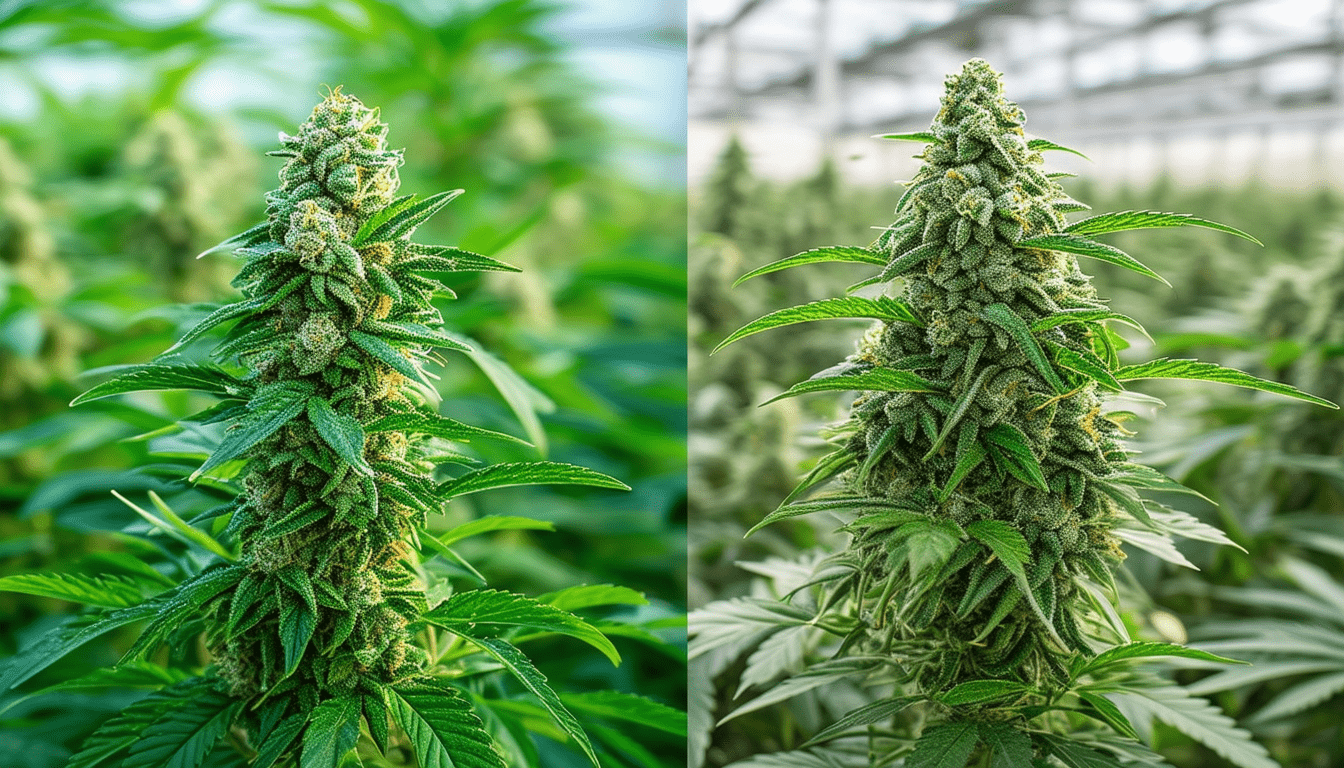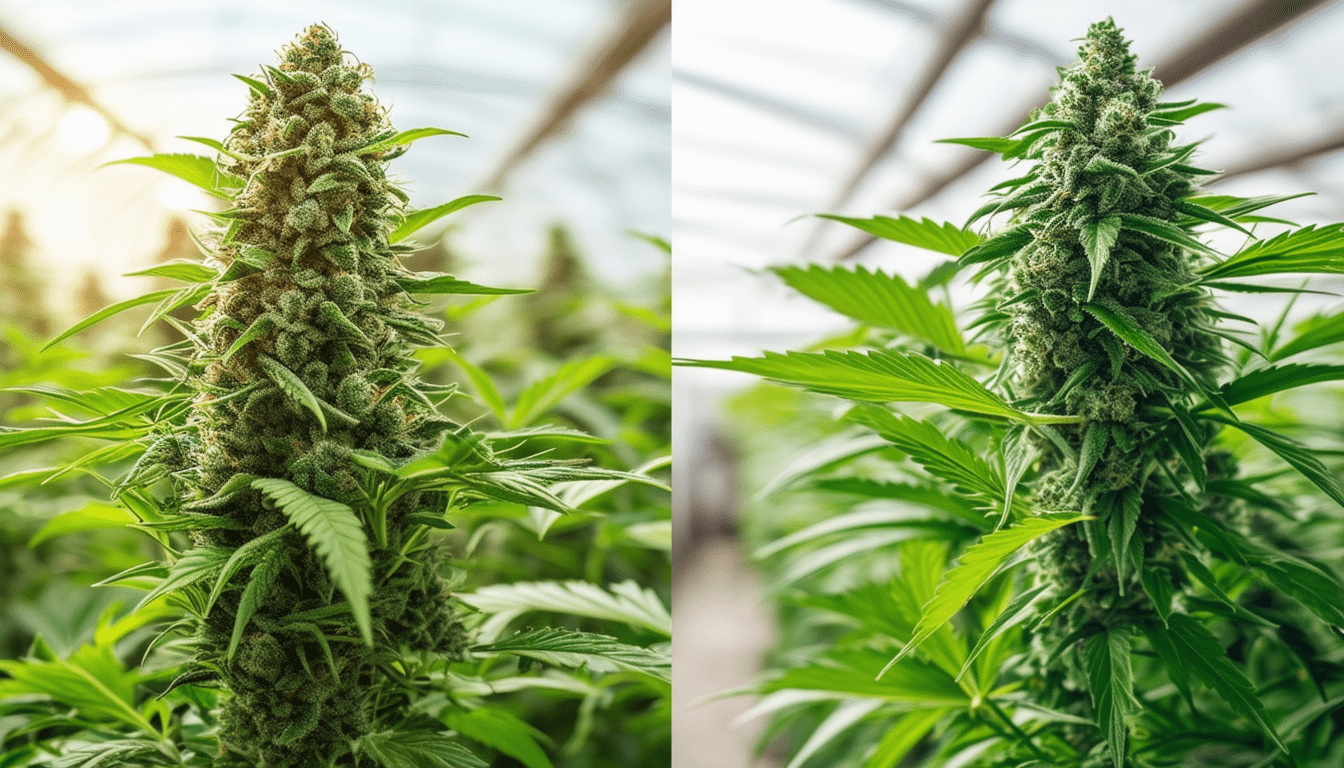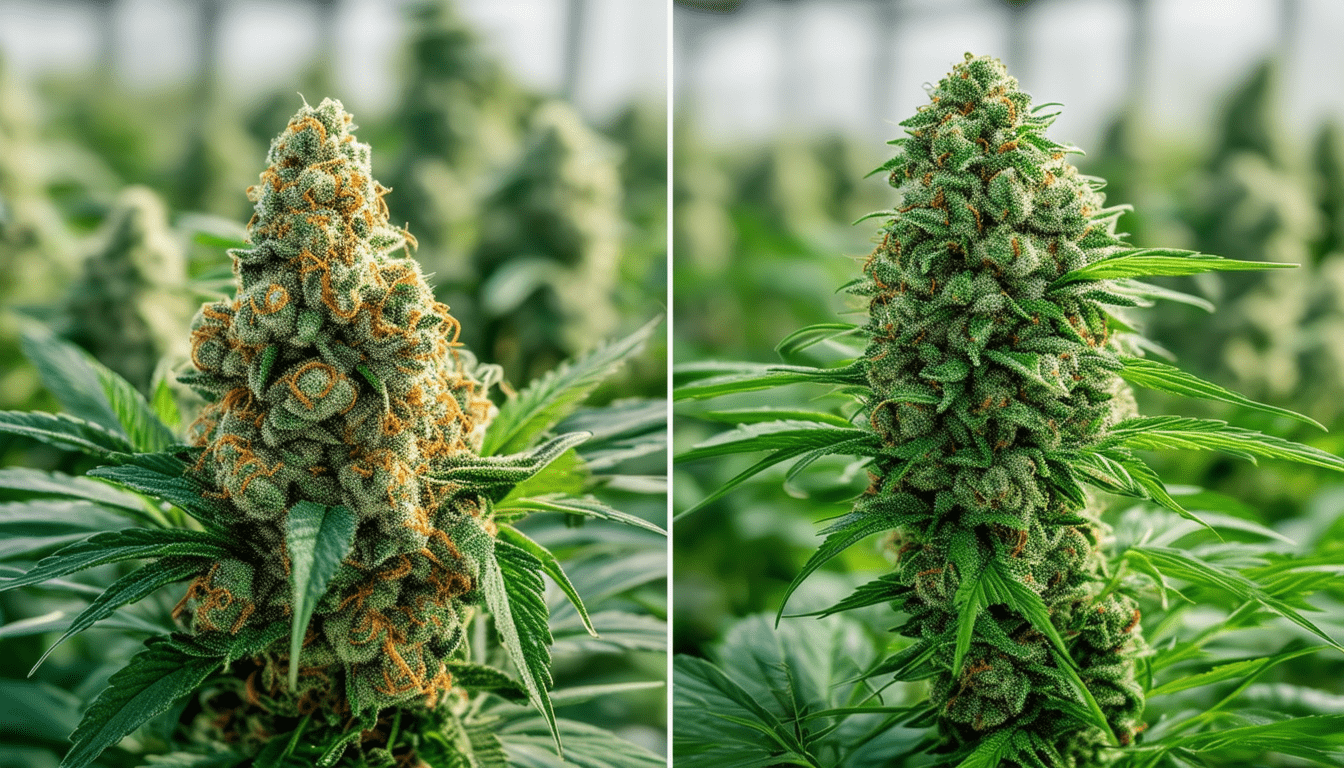Study Finds Federally Approved Research Cannabis Closely Resembles Commercial Varieties, Yet Some Experts Remain Skeptical
|
IN BRIEF
|
A recent study has revealed that cannabis produced under federal approval displays a remarkable similarity to strains available in state-legal commercial markets. The research highlights that the primary cannabinoid profile of federally approved cannabis aligns closely with that of cannabis found in various regions across the United States. However, this conclusion has stirred a degree of skepticism among some experts within the field, who question the reliability and quality of government-supplied cannabis, citing historical discrepancies and potential shortcomings in the research cannabis provided by federal agencies. This ongoing debate underscores the complexities surrounding cannabis research and regulation in the United States.

A recent study indicates that marijuana available for research purposes under federal approval exhibits cannabinoid profiles strikingly similar to those found in commercial cannabis sold in state-legal markets. This finding challenges previous notions regarding the distinct differences between federally supplied cannabis and that found in dispensaries across the nation. However, skepticism persists among certain experts regarding the quality and reliability of federally produced cannabis.
Key Findings of the Study
The study, led by scientists with exclusive authorization to cultivate cannabis for research, revealed that the cannabinoid concentrations of cannabis samples from across the United States predominantly fall within a similar range. The predominant cannabinoid, Δ9-THC, was found to be in the 10 to 20 percent range in samples analyzed, which included both illicit and legal cannabis.
Interestingly, the research also disclosed that the chemical profiles of these samples align closely with those produced at the National Institute on Drug Abuse (NIDA) facility. This suggests that marijuana available to consumers in state-legal marketplaces could potentially mirror the characteristics of federally approved research cannabis.
Regional Variations and Their Impact
One of the more contentious claims of the study stems from its assertion that regional variations in growing practices do not significantly affect cannabinoid content. Instead, the primary determinant of a cannabis strain’s chemical makeup rests within its genetic lineage, rather than environmental influences or cultivation techniques.
This positions cannabis genetics as a critical factor in shaping the overall profile of cannabis products found on the market. The implication is profound: as breeders and cultivators continue to optimize genetics, the notion that cannabis products can vary markedly based solely on regional growing methods is being challenged.
The NIDA Drug Supply Program Under Scrutiny
The study’s findings draw attention to the NIDA Drug Supply Program, which has faced criticism in the past regarding the quality of cannabis provided for research. Critics argue that federally provided cannabis samples were often subpar or contaminated, raising questions about their utility for serious clinical research.
Instances from past studies, such as the 2017 controversy involving PTSD research among military veterans, highlighted reports of NIDA’s cannabis being virtually unusable due to mold contamination and discrepancies in potency. This legacy of skepticism lingers among some researchers who have expressed doubt over whether current federally supplied cannabis has improved substantially.
Research Methodology and Implications
The methodology employed in this latest research involved a comprehensive analysis of diverse cannabis samples sourced from various states, encompassing both legal and illicit markets. The approach aims to provide a more nuanced understanding of cannabis’ chemical profiles across the United States, particularly in light of the evolving legalization landscape.
Moreover, the researchers argue that their findings should be seen as a stepping stone to potentially realigning the understanding of cannabis quality in both federal and commercial applications. They prompt a reconsideration of how cannabis is researched and perceived across grassroots advocacy and public health dimensions.
Expert Skepticism Endures
Despite the findings, several experts remain unconvinced. Criticism primarily revolves around the argument that federally cultivated cannabis, although genetically aligned with commercial counterparts, may still lack crucial components that enhance the entheogenic experiences typically associated with higher-grade recreational cannabis on the market.
Furthermore, the historical backdrop of quality disputes tied to NIDA complicates the narrative. Some researchers claim that the potential differences in cannabinoid interactions may not simply stem from concentrations but also from the presence of terpenes and other cannabinoids, which play essential roles in creating nuanced effects. This complexity leads critics to assert that similar cannabinoid content does not guarantee equivalent pharmacological effects.
Future Directions in Cannabis Research
As cannabis research continues to evolve, the calls for more diverse sources of research cannabis grow louder. The demand for higher-potency products reflects a broader shift in consumer preferences and validates the need for expanded cultivation practices beyond the confines of federally sanctioned programs.
Moreover, the necessity for transparency in the quality of marijuana shared under the NIDA program should remain a priority, particularly as the public seeks to understand the implications of both federally approved and commercial products. The ongoing debate regarding cannabis quality will undoubtedly play a pivotal role in shaping future policies and research agendas.
In conclusion, the study underscores a critical turning point in understanding cannabis quality and consistency across legal frameworks, yet not everything is settled among industry professionals. For ongoing advancements, ensuring the integrity of research methods and findings will be essential in advocating for effective and equitable cannabis policies nationwide.
Comparison of Cannabis Types Based on Cannabinoid Content
| Type of Cannabis | Characteristics |
| Federally Approved Research Cannabis | Primarily low potency, averaging 10-20% THC; grown under strict regulations. |
| Commercial Cannabis | Higher variability in potency, often exceeding 20% THC; influenced by consumer demand. |
| Quality Control | Government oversight and standardized processes in research; however, some skepticism about quality remains. |
| Genetics | Both types exhibit genetic consistency influencing cannabinoid profiles; minimal regional variations. |
| Perception | Research cannabis has faced criticism regarding quality; many advocates argue it does not meet user expectations. |
| Research Accessibility | Access limited to NIDA-approved programs, whereas commercial cannabis is broadly available in state-legal markets. |

A recent study conducted by a team authorized to cultivate marijuana for research purposes has revealed that cannabis widely available on U.S. markets shares a remarkably similar chemical profile to federally approved research cannabis. This new research, which analyzed samples across various states, indicates that the primary differences in cannabinoid content are due to genetics rather than regional growing practices. However, this conclusion has raised eyebrows among some experts who remain doubtful about the quality and applicability of the research cannabis.
Key Findings of the Study
The findings of the study, published in Frontiers in Public Health, suggest that marijuana seized or cultivated across the United States displays cannabinoid profiles averaging between 10 percent and 20 percent THC. The lead researcher concluded that “it really doesn’t matter what materials you have, doesn’t matter where it’s produced, doesn’t matter where it’s seized,” underscoring the significance of genetic factors in determining cannabis quality. This assertion leads many to consider the implications of uniformity in cannabis products.
Comparison with National Institute on Drug Abuse (NIDA) Cannabis
Another controversial claim from this study posits that state-legal cannabis is not only similar among states but also closely resembles the cannabis produced by the National Institute on Drug Abuse (NIDA). Historically, the NIDA’s cannabis has been criticized for its alleged inferiority. Complaints have included issues such as inconsistency in potency and even contamination, which have cast doubts on the reliability of NIDA-generated materials. This raises important questions about the validity of comparing commercial varieties with NIDA supplies.
Experts’ Concerns and Critiques
Despite the optimistic findings, some experts remain skeptical, particularly regarding the NIDA’s standards and the practical applications of its cannabis products in research settings. For instance, researcher Sue Sisley recalled past instances when NIDA’s cannabis failed to meet experimental needs. Critics argue that while the genetic profile may match, the actual experience and effectiveness of these products can differ significantly. This skepticism is critical for the ongoing discussions about clinical and recreational cannabis and its research efficacy.
The Shift in Research Cannabis Production
The cannabis production landscape has evolved significantly, with the NIDA’s program recently focusing on cultivating higher potency strains to cater to the increasing demand from researchers. This shift, intended to parallel commercial market trends, raises the question of how well NIDA’s research materials can adapt to reflect the variances found in today’s cannabis marketplace. Many researchers advocate for a diversification of cannabis sources to diminish the monopolistic grip NIDA has had historically on federally approved cannabis.
The Future of Cannabis Research
As the debate over the similarities and differences between federal and commercial cannabis continues, it is essential to acknowledge the growing body of research that supports both sides. The need for more reliable, consistent cannabis for research can’t be overstated, especially in light of expanding commercial markets and evolving laws. As scientific inquiry progresses, understanding the nuances between federally approved cannabis and its commercial counterparts will be pivotal in shaping future policies and research opportunities.
For further insights into the cannabis landscape, including product reliability and comparative studies, consider exploring articles on understanding cannabis edibles and natural remedies with cannabis for holistic healing.
- Study Conclusion: Federally approved research cannabis has similar cannabinoid profiles to commercial cannabis.
- Primary Cannabinoids: High Δ9-THC cannabis samples average between 10% and 20% THC content.
- Genetic Factors: Genetic makeup of the plant, rather than regional growing conditions, influences cannabinoid content.
- Regulatory Oversight: Cannabis grown for research by the University of Mississippi is federally regulated.
- Quality Concerns: Past criticisms regarding the quality of NIDA’s cannabis raised skepticism among researchers.
- Contamination Issues: Previous reports highlighted possible mold contamination in federally supplied samples.
- Current Developments: The NIDA has adjusted THC levels in cannabis, producing samples with up to 25% THC.
- Research Demand: Recent requests for proposals indicate an increasing demand for high-quality cannabis research material.
- Experts’ Skepticism: Some researchers remain doubtful about the equivalency of federally approved cannabis to market varieties.
- Future Studies: Ongoing studies may incorporate or compare federally supplied cannabis with higher-potency products from state-legal markets.
Summary of Findings
A recent study has revealed that cannabis produced under federal research programs closely resembles products available in commercial markets regarding their cannabinoid profiles. Despite these findings, some experts express skepticism about the quality and implications of federally approved marijuana, citing historical issues with research-grade cannabis quality and ongoing concerns regarding the legitimacy of the conclusions drawn from such studies.
Understanding the Cannabinoid Profiles
The study highlighted that cannabis samples seized from various regions of the United States demonstrated striking similarities in cannabinoid content, typically ranging from 10 percent to 20 percent THC. The authors argue that genetic factors largely dictate these profiles, dismissing the significance of regional growing differences. This finding challenges the preconceived notion that geographic variations would lead to diverse chemical compositions in cannabis.
Implications for Research and Commercial Cannabis
With the assertion that the chemical profile of federally approved research cannabis aligns closely with commercially available products, it raises significant questions about the accessibility of high-quality cannabis for scientific inquiry. Researchers may rely on federally supplied cannabis as a benchmark, yet the implication that this material is equivalent to legal cannabis raises concerns about research bias and the representation of real-world marijuana experiences.
Historical Context of Research Cannabis Quality
Concerns over the quality of cannabis supplied by federal programs are not new. Historically, studies have criticized the National Institute on Drug Abuse (NIDA) for providing substandard marijuana strains that do not adequately reflect the quality of cannabis available in the legal market. Researchers have reported issues such as contamination and unrepresentative potency in samples received from NIDA. Such past criticisms contribute to ongoing skepticism regarding present claims that federal research cannabis is comparable to commercial varieties.
Call for More Diverse Research Sources
Given the historical deficiencies in federally supplied cannabis, there is a compelling argument for diversifying research sources. Encouraging the inclusion of multiple growers—especially those experienced in production techniques that yield higher-quality cannabis—could lead to improved outcomes in research. By broadening the range of available cannabis products for study, researchers could more accurately represent the complexities of the cannabis market and its potential therapeutic benefits.
Addressing Skepticism within the Scientific Community
Skepticism among experts regarding the conclusions drawn from the study indicates the necessity for transparency and replication within cannabis research. It is crucial for future studies to address concerns about product quality and ensure that samples are representative of the broader market. Assertions that federally approved cannabis is analogous to commercial products require rigorous peer review, with an emphasis on verifying the reproducibility of results.
Moving Forward with Caution
As commercial cannabis markets flourish, the necessity for high-caliber research cannabis becomes increasingly apparent. Policymakers and researchers must tread cautiously, ensuring that any health claims regarding federally supplied cannabis reflect its actual efficacy and quality when compared to commercial alternatives. Integrating both scientific rigor and regulatory oversight will be essential in shaping a nuanced understanding of cannabis and its applications.
Future Research Directions
Further studies should investigate the variability in cannabis quality across states and its implications for public health. Focusing on cognitive, psychological, and physiological effects may yield valuable insights that can help regulatory bodies understand the impact of cannabis at both medical and recreational levels. Only through thorough and diverse research can we begin to appreciate the complexities inherent in cannabis strains and their diverse applications.
FAQ: Study on Federally Approved Research Cannabis
What did the recent study find about cannabis varieties in the U.S.? The study revealed that cannabis available across the country is “basically the same” in terms of its primary cannabinoid content, implying that genetics are the primary factor rather than regional growing differences.
What was the average THC content found in the analyzed samples? The samples analyzed averaged between 10 percent and 20 percent THC, with a chemical profile that did not vary significantly across different states or regions.
How does federally approved cannabis compare to commercial cannabis? The study asserts that marijuana available in state-legal markets is very similar to the chemical profile of the research cannabis provided through the National Institute on Drug Abuse (NIDA) Drug Supply Program.
What criticisms have been raised about NIDA’s cannabis quality in the past? Historically, there has been criticism regarding the quality of cannabis supplied by NIDA, with researchers previously stating that the material did not resemble cannabis and was sometimes contaminated.
What has changed in NIDA’s cannabis production recently? NIDA is reportedly moving toward producing higher-potency varieties in response to demands for more effective materials for research, including cannabis with higher than 10 percent THC content.
Are there still researchers skeptical about NIDA’s cannabis offerings? Yes, some experts continue to question the quality of NIDA-released cannabis, pointing to prior experiences and the need for more robust and commercially viable research materials.
What is the significance of growing cannabis genetics? The study emphasizes that the genetic makeup of cannabis plants is the determining factor for their cannabinoid profiles, which impacts the pharmacology and potential therapeutic benefits.
How does the current market demand influence federal cannabis research? Federal agencies are recognizing increased demand for higher potency cannabis in research, leading to requests for proposals to enhance the production and availability of controlled substances for research purposes.
Is the NIDA cannabis still used for clinical studies? Yes, NIDA grows cannabis for researchers, but due to past issues, many are seeking cannabis from commercial sources for clinical trials, especially for phase 3 studies.





Post Comment